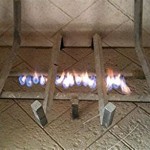How to Put Stacked Stone Over a Brick Fireplace
Transforming a brick fireplace with stacked stone can dramatically enhance the aesthetic appeal of a living space. This project, while requiring some effort and attention to detail, is achievable for many homeowners with basic DIY skills. This article provides a step-by-step guide on how to successfully install stacked stone over an existing brick fireplace, covering preparation, installation, and finishing touches.
Before commencing the project, it is crucial to assess the fireplace's condition and determine the suitability of the brick surface for accommodating the added weight of the stacked stone. A structurally sound brick fireplace is essential for a successful and long-lasting installation. Inspect the brick and mortar for any signs of damage, such as cracks, crumbling, or loose bricks. Address any necessary repairs before proceeding with the stone application.
Safety is paramount throughout the process. Wear appropriate personal protective equipment (PPE), including safety glasses, gloves, and a dust mask. Ensure adequate ventilation in the work area. Disconnect any electrical outlets or gas lines in the immediate vicinity of the fireplace to prevent accidents. Familiarize yourself with the tools and materials involved and their respective safety precautions.
Key Point 1: Preparation and Surface Evaluation
The preparation phase is arguably the most critical aspect of installing stacked stone over brick. A thoroughly prepared surface ensures proper adhesion of the stone and prevents future issues. This stage involves cleaning the brick, roughening the surface, and applying a bonding agent.
Begin by thoroughly cleaning the brick surface. Remove any dust, dirt, soot, or grease using a wire brush and a mixture of water and a degreasing cleaner. Rinse the surface thoroughly with clean water and allow it to dry completely. This process will ensure that the bonding agent and mortar adhere properly to the brick. A clean surface promotes optimal bonding and prevents future delamination of the stacked stone.
After cleaning, roughen the brick surface to create a better mechanical bond. This can be achieved using a grinder with a masonry grinding wheel or a wire brush attachment. The objective is to create a slightly textured surface that provides more grip for the mortar. Be careful not to remove too much material, as this could weaken the brick. A roughened surface increases the surface area available for bonding, resulting in a stronger and more durable installation.
Next, apply a bonding agent to the brick surface. A bonding agent, typically a latex-modified mortar additive or a specialized masonry primer, improves the adhesion between the brick and the mortar. Apply the bonding agent according to the manufacturer's instructions, ensuring complete coverage of the brick surface. Allow the bonding agent to dry completely before proceeding to the next step. The bonding agent acts as an intermediary layer, creating a chemical bond between the brick and the mortar, further enhancing adhesion.
Once the bonding agent is dry, assess the plumbness of the brick surface. If the brick is significantly out of plumb, it may be necessary to apply a leveling coat of mortar to create a flat and even surface for the stacked stone. This is particularly important for achieving a professional-looking finished product. Use a level to check the vertical alignment of the brick and apply mortar as needed to correct any imperfections. Allow the leveling coat of mortar to cure completely before proceeding.
Before starting the actual installation of the stacked stone, plan the layout. Dry-fit the stones on the floor to determine the best arrangement and minimize cuts. Consider the overall aesthetic you wish to achieve and how the stones will interact with any existing features of the fireplace, such as the mantel or hearth. This pre-planning step will save time and prevent errors during the installation process.
Key Point 2: Stacked Stone Installation
The installation of the stacked stone requires careful attention to detail and a systematic approach. Selecting the appropriate mortar, mixing it correctly, and applying it properly are crucial for achieving a strong and aesthetically pleasing result.
Choose a mortar specifically designed for stone veneer applications. Polymer-modified mortars are generally recommended for their superior bonding strength and flexibility. These mortars are formulated to accommodate the slight movements that can occur in masonry structures, preventing cracks and delamination. Consult with a building supply professional to select the most suitable mortar for your specific type of stacked stone and brick.
Mix the mortar according to the manufacturer's instructions. Add water gradually until you achieve a smooth, workable consistency. Avoid adding too much water, as this can weaken the mortar. Use a mixing drill with a paddle attachment to ensure thorough mixing. Allow the mortar to slake for the recommended time before using it. A well-mixed mortar is essential for achieving a strong and durable bond.
Apply the mortar to the back of each stone using a notched trowel. The notch size will depend on the size and texture of the stone. Apply enough mortar to ensure good contact with the brick surface, but avoid applying so much that it oozes out between the stones. Apply a thin layer of mortar to the brick surface as well. This "back-buttering" technique helps to improve adhesion. The mortar should be evenly distributed on both the stone and the brick to maximize bond strength.
Press the stone firmly against the brick, wiggling it slightly to ensure good contact with the mortar. Maintain consistent spacing between the stones. Use shims if necessary to maintain consistent spacing and alignment. Start at the bottom of the fireplace and work your way up, row by row. This approach allows gravity to work in your favor, preventing the stones from sliding down before the mortar sets.
Clean any excess mortar from the face of the stones with a damp sponge. Do this before the mortar hardens completely. Avoid smearing the mortar onto the stone surface, as this can be difficult to remove later. Use a clean sponge and fresh water frequently to prevent staining. Maintaining a clean working environment will contribute to a professional-looking finished product.
Periodically check the level and plumb of the stones as you work. Use a level and a straight edge to ensure that the stones are properly aligned. Make any necessary adjustments before the mortar sets. Paying attention to these details throughout the installation process will ensure a professional and aesthetically pleasing result.
Key Point 3: Cutting and Finishing
Cutting the stacked stone to fit around corners, edges, and other obstructions is often necessary. A wet saw with a diamond blade is the ideal tool for this task. Finishing touches, such as applying a sealant and cleaning the final surface, are also important for protecting the stone and enhancing its appearance.
Use a wet saw with a diamond blade to cut the stacked stone. A wet saw provides a clean, precise cut and helps to control dust. Wear safety glasses and ear protection when operating the wet saw. Measure and mark the stone accurately before cutting. Cut the stone slowly and steadily, allowing the blade to do the work. A properly cut stone will fit seamlessly into the overall design.
For inside corners, miter the edges of the stones at a 45-degree angle. This creates a clean, professional-looking corner. Use a wet saw to make the miter cuts. For outside corners, either miter the edges of the stones or use corner pieces specifically designed for stacked stone. Corner pieces provide a more durable and aesthetically pleasing finish.
Allow the mortar to cure completely according to the manufacturer's instructions. This typically takes 24 to 72 hours. Avoid disturbing the stones during the curing process. Once the mortar is fully cured, remove any shims and clean the surface of the stacked stone with a soft brush and clean water. Avoid using harsh chemicals or abrasive cleaners, as these can damage the stone.
Consider applying a sealant to the stacked stone. A sealant will protect the stone from moisture, stains, and other environmental factors. Choose a sealant specifically designed for stone veneer applications. Apply the sealant according to the manufacturer's instructions. A sealant will help to preserve the appearance of the stacked stone and extend its lifespan.
Finally, inspect the finished installation and make any necessary touch-ups. Fill any gaps or cracks with mortar or caulk. Clean any remaining mortar residue from the stone surface. Step back and admire your work. A well-executed stacked stone fireplace can dramatically enhance the beauty and value of your home.

Faux Stone Fireplace Surround Over Old Brick Genstone

How To Cover A Brick Fireplace With Stone

How To Diy A Stacked Stone Feature Over Existing Brick

Walter S Diy Chimney Remodel Stone Over Brick Genstone

Installing Stone Veneer Over A Brick Fireplace Grand River

Thin Stone Veneers Make A Fireplace Update Easy Swenson Granite 100 Natural Stones

Read This Before Your Stone Fireplace Makeover Understanding Undertones

Transform Your Home Stone Veneer Over Brick Fireplace Guide

Diy Stacked Stone Fireplaces On A Budget Msi Blog

Install Stone Veneers Over Old Brick Fireplace Diy
Related Posts








